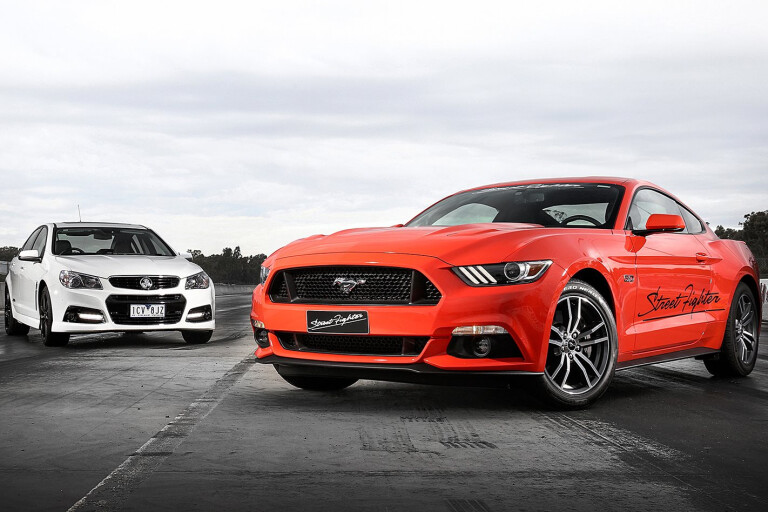
Five years ago, Ford global chief Alan Mulally was being harassed at the Detroit Motor Show about whether the rear-drive Falcon would live on. “You’ll have Mustang,” he quipped before his henchmen ended the conversation.
It all makes sense now.
With Falcon set to be killed next year, there would have been no rear-drive car with a Ford badge on sale in Australia, a situation that some interpretations of the New Testament suggest could bring on the four horseman of the apocalypse and end civilisation as we know it.
Thankfully, the world’s most powerful ginger ensured this would not happen by putting his big rubber stamp on a plan to produce the Mustang with the steering wheel on the correct side of the dashboard for the first time in the iconic Ford’s 51-year history.
 Ford Australia will start selling the factory right-hand-drive Mustang locally late this year and already has more than 2000 orders. There will be a four-cylinder turbo for $44,990 and a GT V8 for $54,990 (convertibles will cost $53,990 and $63,990 respectively).
Ford Australia will start selling the factory right-hand-drive Mustang locally late this year and already has more than 2000 orders. There will be a four-cylinder turbo for $44,990 and a GT V8 for $54,990 (convertibles will cost $53,990 and $63,990 respectively).
Of course, MOTOR couldn’t wait and managed to snaffle a drive of a private new-generation pony car import on Australian bitumen.
Driving the great American dream car wasn’t enough, though. No, we had to put it up against the mighty Holden Commodore SS.
 While it might have an American heart (as those clever lads with their Chevrolet badges have worked out), the SS is an Australian icon. The $52,490 SS V Redline has seen off the brutally powerful but ageing XR8 Falcon thanks largely to its sharper handling package, but how will it fare against the all-new Mustang?
While it might have an American heart (as those clever lads with their Chevrolet badges have worked out), the SS is an Australian icon. The $52,490 SS V Redline has seen off the brutally powerful but ageing XR8 Falcon thanks largely to its sharper handling package, but how will it fare against the all-new Mustang?
The last time Ford Australia sold the Mustang (apart from a handful of 1960s cars) was in 2001, when Prodrive handled the left-hand to right-hand drive conversions. It had a cracking V8 engine, but the car it was bolted into was bad and the handling was ordinary.
 I remember the body was so wobbly the convertible’s lid wouldn’t shut if the ground beneath the car was just a little bit uneven.
I remember the body was so wobbly the convertible’s lid wouldn’t shut if the ground beneath the car was just a little bit uneven.
The next-generation car, which never made it to Australia, was not much better. Interestingly, American Mustang engineers were asked to jointly develop an independent rear suspension system with Ford Australia whitecoats, but they thought the Control Blade IRS of the 2002 BA Falcon was not refined enough and progressed with a more complicated system, which was then canned by the bean counters to reduce program costs.
As a result, the Mustang maintained a chariot-style solid rear axle that furthered its reputation of being a bucket with a great engine.
 So, I must admit that I wasn’t sure what to expect when we turned up to Anglesea’s Automotive Research Centre to test a left-hand drive Mustang GT imported by Adelaide-based KPM Motorsports.
So, I must admit that I wasn’t sure what to expect when we turned up to Anglesea’s Automotive Research Centre to test a left-hand drive Mustang GT imported by Adelaide-based KPM Motorsports.
The company will use it as a development model for a series of high performance parts it’s going to build for Australian and US Mustang customers to be offered through Ford dealers.
The brand-spanking new Mustang is a California car (so no rust then), purchased straight from a Ford dealer in the sun-blessed state and shipped here.
Decked out in a brilliant shade of orange, it pops out of the dreary grey scenery in cold Victoria.
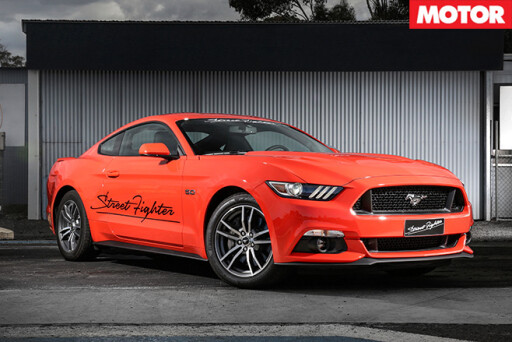 It looks awesome, with its long bonnet, classic coupe side profile and those tail lights from Mustangs of old.
It looks awesome, with its long bonnet, classic coupe side profile and those tail lights from Mustangs of old.
The GT does look a little under-tyred on its 18-inch wheels, but this is not the same spec that Ford Australia will be selling.
All the Australian Mustangs will get the Performance Pack, which means wider 19-inch wheels, retuned springs, a thicker rear sway bar and front strut brace as well as a shorter final drive ratio of 3.73:1 (our car has 3.55:1) and six-piston front Brembos.
The KPM test Mustang is also fitted with US-spec all-weather tyres, which have less grip, but will apparently be very good if there is a snowstorm.
 I can’t wait any longer and open the long door so I can slide into the cabin.
I can’t wait any longer and open the long door so I can slide into the cabin.
The interior is a mixed bag. There are some cool bits, but some of the plastics are sub-par. But to call out the surface quality of the Mustang interior is like criticising Mad Max: Fury Road for not having enough dialogue as a vehicle for character development.
There are some nice touches though. The steering wheel has a cool retro design and looks like it has been chiseled from a big chunk of aluminium. It has a leather-wrapped rim that is perfectly shaped and there is easy access to the flappy gearshift paddles located behind it.
There is a neat build plate on the other side of the dashboard that says ‘Mustang, since 1964’, which is a fitting link to its rich past.
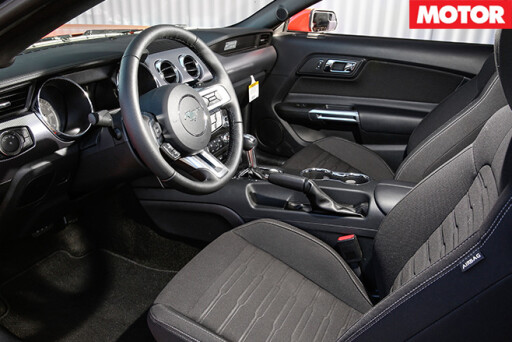 Ford missed the mark with the instrument cluster, which uses generic fonts for its numbers and letters.
Ford missed the mark with the instrument cluster, which uses generic fonts for its numbers and letters.
Now, I don’t want to be one of those fontophiles who bore people at dinner parties with the pros and cons of Helvetica and Times New Roman, but this speedo and tacho font is lame compared to the long number retro font from the last generation Mustang that recalled the glory of the 1960s and ’70s.
The rest of the Mustang dashboard is your standard Ford fare; there is a sound system, climate control, an ignition button and some cupholders. It has standard seat trim, which is kind of like sneaker fabric, and the seats, at least the front two, are supportive.
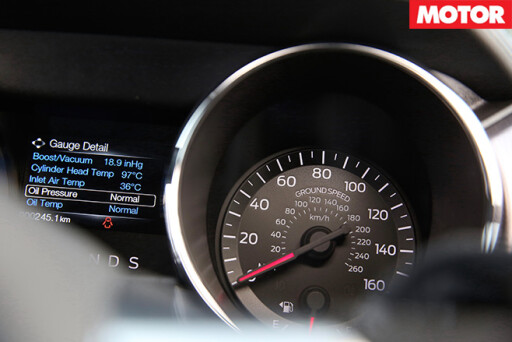 I did squeeze into the back and can attest that the rear seats are only really for children, ¾ sized adults, or full-sized adults who are extremely keen to go for a ride in a Mustang and don’t care about bending their spine for a short period.
I did squeeze into the back and can attest that the rear seats are only really for children, ¾ sized adults, or full-sized adults who are extremely keen to go for a ride in a Mustang and don’t care about bending their spine for a short period.
One feature that stands out in the cabin is the handbrake. It is an actual cable-type handbrake, which is a real blast from the past and contrasts to the electric park brake in the Commodore SS V Redline.
Whether Ford included this for handbrake turns or to save money and weight, we’ll never know, but I can confirm that it does work and you can bring on a silde by giving it a yank at the right moment.
I press the Start button and the V8 lurking under the long bonnet fires up with a satisfying growl.
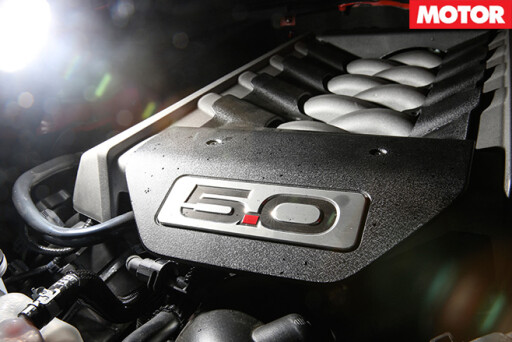 After sliding the shifter into Drive, it is time to ease away.
After sliding the shifter into Drive, it is time to ease away.
The driver’s view is a crucial part of the Mustang’s muscle car vibe. You can see a big bonnet with not just bulges, but vents as well. The only way they could make it more manly would be to strap a jackhammer and a giant raw steak on top.
The bonnet is so long and lifts up when I hit the accelerator as it surges towards the horizon. It’s like riding an extremely powerful oversized carrot.
And damn, does it feel fast.
The acceleration is something you expect from an engine considerably larger than 5.0-litres or one force fed.
A later run down the drag strip at Heathcote confirms my seat of the pants evaluation. The stock Mustang is good for a 4.9sec 0-100km/h and a cracking 13sec-flat quarter mile.

With a healthy 542Nm on tap and 325kW at the top of the rev range, I shouldn’t be surprised it’s so fast.
The wonderful V8 soundtrack adds to the impression of speed. It is guttural and fills the cabin, a much more aurally rewarding experience than the muted Commodore SS.
After some high speed runs, it is time to hit the Bosch skid pan and ask the age-old question: “Will it slide?”
The answer is a resounding yee-hah, which is means yes in this context. The Mustang steps out at the first request and the slide is long and easy to control.
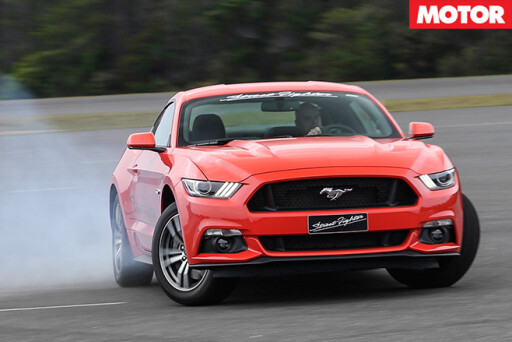 We’ll have to wait and see what affect the all-weather tyres have on this aspect, but this test car is delightfully playful and encourages the driver to hang the back and keep it there.
We’ll have to wait and see what affect the all-weather tyres have on this aspect, but this test car is delightfully playful and encourages the driver to hang the back and keep it there.
The Mustang feels like a Toyota 86 that was sent to jail and passed its time pumping weights.
We weren’t able to take the unregistered Ford over any uneven roads, but the American stock car does have more body roll than the super sharp Commodore.
It doesn’t have the loll-about-like-the-village-drunk suspension setting of some American cars and it is predictable, but it is on the softer side. Note the Australian Mustangs will no doubt handle differently.
Now it’s time to ask another important question: “Will it burnout?”
You might have noticed the Mustang comes standard with a Line Lock function in all markets except good old Nanny Nation (Australia), which allows for a car-controlled stationary burnout.
The omission doesn’t really matter because the V8 Mustang does burnouts ridiculously easily.
With 542Nm on tap, you could pluck a giant squid out of the nearby ocean, shove it into the Mustang and the odds are it could drum up a big smokey burnout from the rears.
Besides, I reckon if you need a car’s computer to help you do a burnout, you probably shouldn’t be doing a burnout. In fact, you should probably just catch the bus and suffer in your jocks.
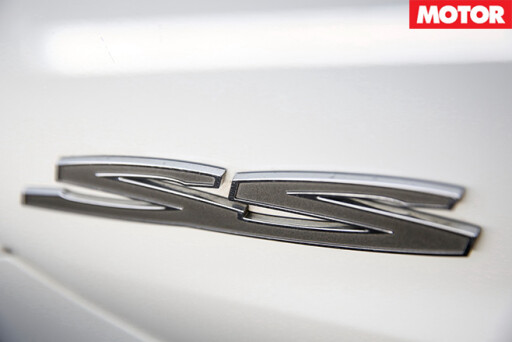 Now it’s time for a run in the mighty SS. This one is a top-spec SS V and its interior is a much more complete design and looks far better planned and finished than the Mustang’s. It also has a head-up display, leather seats and a vast expanse of space.
Now it’s time for a run in the mighty SS. This one is a top-spec SS V and its interior is a much more complete design and looks far better planned and finished than the Mustang’s. It also has a head-up display, leather seats and a vast expanse of space.
Like the Ford, this is a muscle car, but more sensible. There are seats in the back for the family and a far more functional boot.
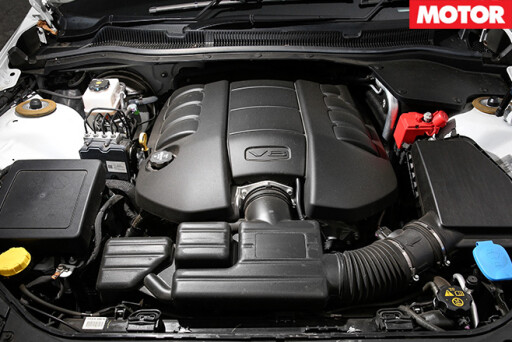 It still gets up and goes, though.
It still gets up and goes, though.
The SS doesn’t have quite the same urge out of the blocks and the 6.0-litre V8 tends to knock off early as the needle heads towards 5000rpm. You have to work it much harder than the Mustang, which is not surprising given it is down 55kW (the SS is supposed to have 5Nm more torque, but it seems less accessible).
Our later run down the strip showed it is definitely not quite as quick as the Mustang, doing a 5.65-sec 0-100km/h run and running a quarter in the mid-high 13s.
The numbers wouldn’t change, but it would feel faster with an aftermarket exhaust because the stock system means the V8 note feels detached, like it is only happening outside the car.
The SS can burnout and it can slide too, but it is not as keen to get sideways as the Mustang, possibly because it has less power, but it also seems to have better front and rear grip.
 You have to poke the SS in the eye and kick it in the guts to get it to light up and start sliding. It seems bigger and heavier when you throw it around, perhaps because it is (184mm longer and around 50kg heavier), but the body control is excellent. The SS steering is lighter, but is wonderfully communicative.
You have to poke the SS in the eye and kick it in the guts to get it to light up and start sliding. It seems bigger and heavier when you throw it around, perhaps because it is (184mm longer and around 50kg heavier), but the body control is excellent. The SS steering is lighter, but is wonderfully communicative.
Later, on a run from Anglesea along the coast and then inland, the SS reminds us of what a great all-rounder it is, eating up the miles and galloping over some fairly ordinary surfaces.
The Holden is a muscular cruiser that can go hard when you want it to, but can also play the role of the gentle family hauler when required. It is more refined, not just in appearance, but on the road too.
 The Mustang is all go, with its bulges and vents, its louder engine and its willingness to get sideways at the earliest notice. It’s also effectively a two-seater, something that will be a problem for some.
The Mustang is all go, with its bulges and vents, its louder engine and its willingness to get sideways at the earliest notice. It’s also effectively a two-seater, something that will be a problem for some.
Our test is hardly conclusive, but does offer a tantalising preview of what is to come. The muscle car scene in Australia is about to get a whole lot more interesting.
| FORD MUSTANG GT V8 (US SPEC) | HOLDEN COMMODORE SS V REDLINE | |
| Body | 2-door, 4-seat coupe | 4-door, 5-seat sedan |
| Drive | rear-wheel | rear-wheel |
| Engine | 4951cc V8, DOHC, 32v | 5967cc V8, OHV, 16v |
| Bore/Stroke | 92.2 x 92.7mm | 101.6 x 92.0mm |
| Compression | 11.0:1 | 10.4:1 |
| Power | 325kW @ 6500rpm | 270kW @ 5600rpm |
| Torque | 543Nm @ 4250rpm | 530Nm @ 4400rpm |
| Power/Weight | 193kW/tonne | 153kW/tonne |
| Transmission | 6-speed automatic | 6-speed manual |
| Weight | 1681kg | 1766kg |
| Suspension | struts, coil springs, anti-roll bar (f); multi-links, coil springs, anti-roll bar (r) | struts, coil springs, anti-roll bar (f); multi-links, coil springs, anti-roll bar (r) |
| L/W/H | 4784/1916/1381mm | 4966/1899/1471mm |
| Wheelbase | 2720mm | 2915mm |
| Tracks | 1570/1637mm (f/r) | 1593/1590mm (f/r) |
| Steering | electrically-assisted rack-and-pinion | electrically-assisted rack-and-pinion |
| Brakes | 352mm ventilated discs, 4-piston calipers (f); 330mm ventilated discs, single-piston calipers (r) | 355mm ventilated discs, 4-piston calipers (f); 324mm ventilated discs, single-piston calipers (r) |
| Wheels | 18.0 x 8.0-inch (f/r) | 19.0 x 8.5-inch (f); 19 x 9.0-inch (r) |
| Tyres | 235/50 R18 (f/r) Pirelli P Zero Nero all-season | 245/40 R19 (f); 275/35 R19 (r) Bridgestone Potenza RE050A |
| Price as Tested | US$35,000 (approx.) | $52,490 |
| Positives | Superb V8 engine; searing pace: adjustable handling; looks | Great chassis and steering; sedan practicality; value for money |
| Negatives | US chassis quite soft; we have to wait until December to arrive Aussie cars! | Not particularly quick; should sound better; looks a little plain |
| 4/5 | 4/5 |
Click here to read the full range review of the Holden Commodore.

COMMENTS